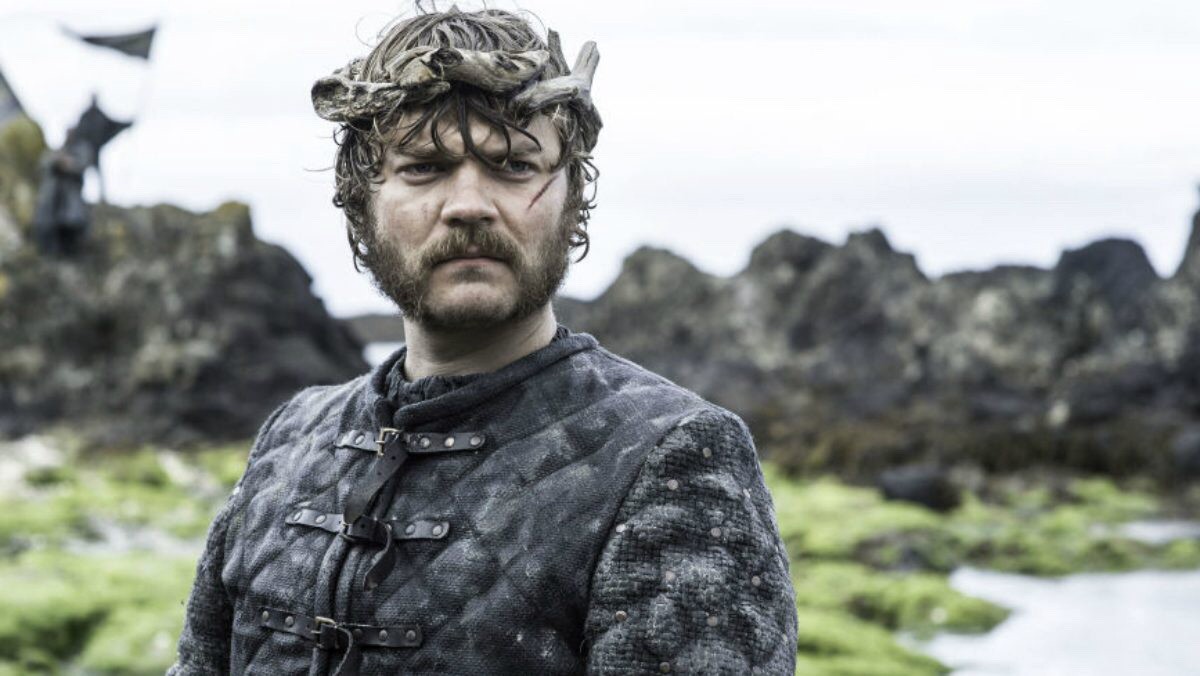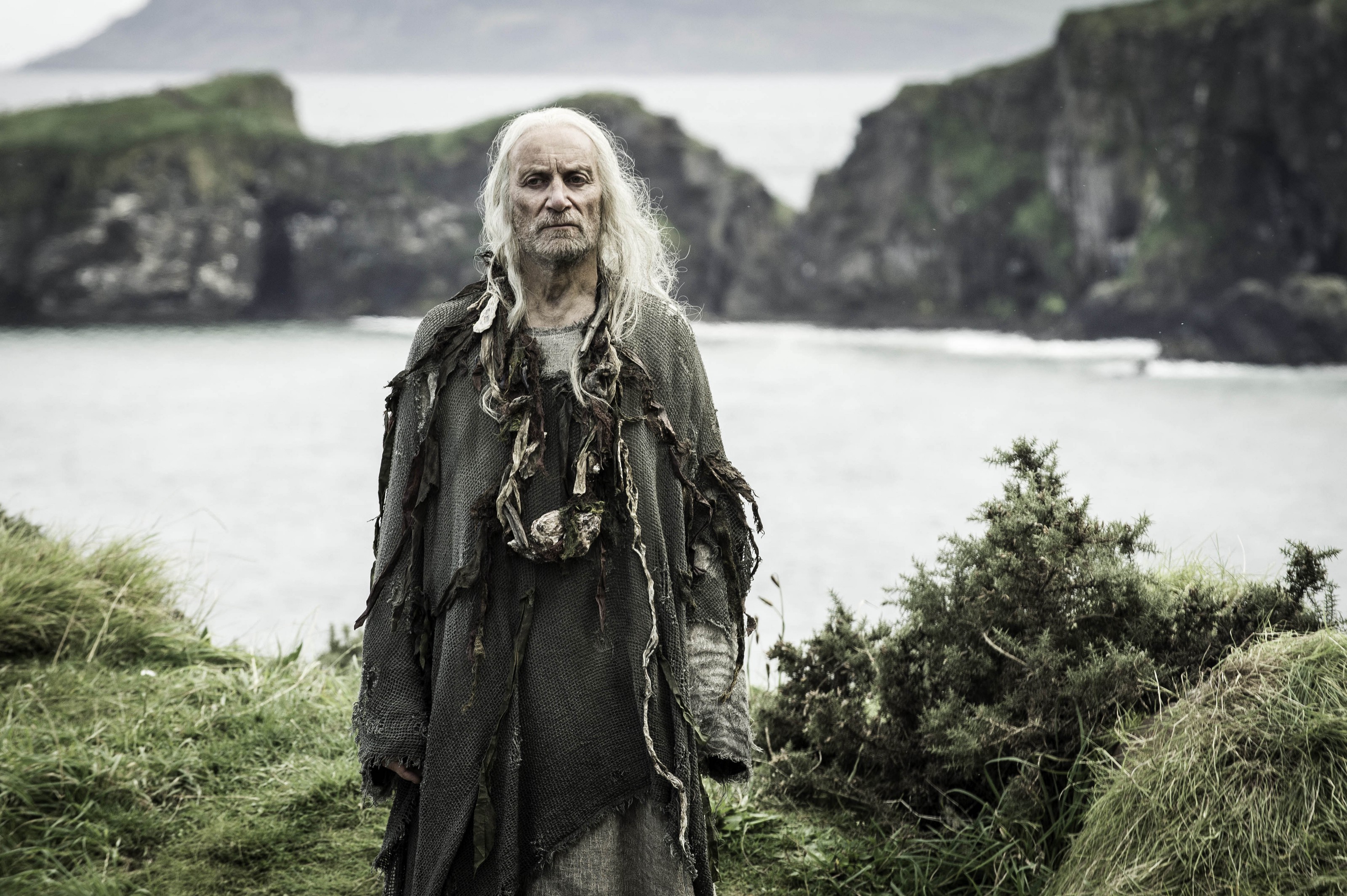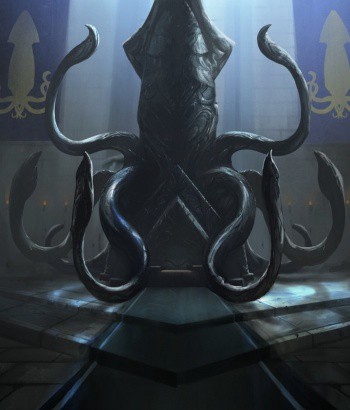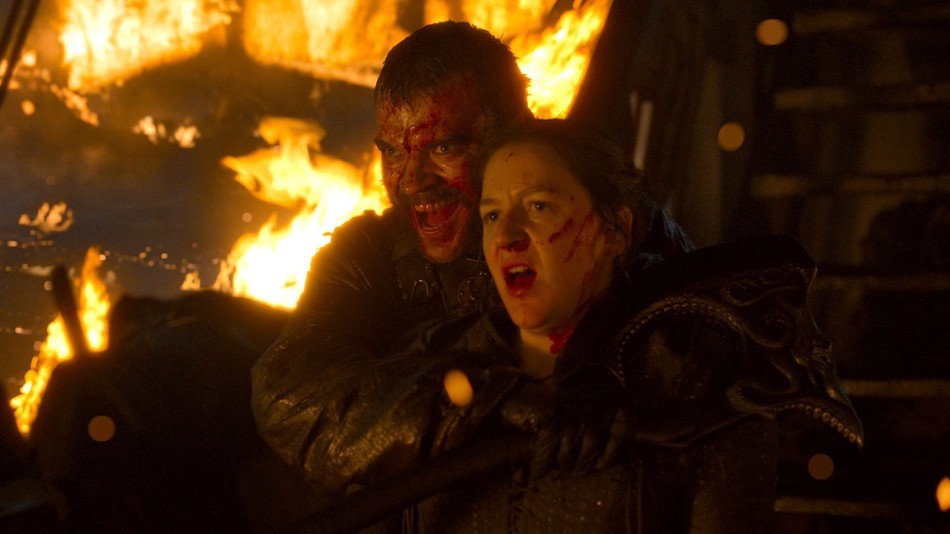
(Warning: contains spoilers for A Song of Ice & Fire, including sample material released by George R.R. Martin but not yet published)
Without a doubt, Euron Greyjoy has emerged as the most divisive character on Game of Thrones. Some find him an amusing breath of fresh air, others regard him as a thinly drawn and uninteresting antagonist brought into the story way too late. He will likely go down as the Windom Earle of this series, and remain a controversial figure well into the show?s afterlife. One thing that?s certain is that actor Pilou Asbaek is having a blast with this role, imbuing Euron with a comical amount of self-aware arrogance as he swaggers and kills his way into Cersei Lannister?s inner circle.
However, in the larger portrait painted between the novels and the HBO adaptation, there?s a lot more going on with Euron Greyjoy than may initially be apparent.
Book vs. Show
Regarding the source material, a portion of book readers no doubt find the show?s characterization of Euron lacking. In A Song of Ice & Fire, he?s much more richly drawn, emerging as perhaps one of the most dangerous people in all of Westeros. But the book and the series are each working with the same template. They portray Euron as a psychotic nihilist eager to grab power . . . not to further any political agenda, but because he views this as an amusing game where only those who embrace amoral chaos can truly succeed and thrive. In either rendition, he?s a campy, scene-chewing villain barely concealing his untrustworthiness and insanity.
Both versions of Euron establish that he doesn?t hide his brutal tendencies, yet he charms others by modulating his persona to suit his audience. He promises glory to the Ironborn and exalts their traditions, but in private finds them to be thuggish idiots with little awareness of the larger world. He believes that other people are so stupid that he can get anything he wants as long as he does the bare minimum to be appealing, and his experience has proven that approach correct.
He?s also a sadist, a fact unrelentingly put across in the novels but played down in the series. Though he?s still joyously cruel on Game of Thrones, it?s nowhere near as horrific as in the book, largely because the show?s depiction of Ramsay Bolton exhausted that avenue and the writers had to find a different way to demonstrate Euron?s villainy.
The book version of Euron also has a dimension as yet unseen on the screen: an all-consuming obsession with magic. After being banished from the Iron Islands for impregnating his brother Victarion?s mistress, Euron pursued arcane knowledge, traveling through Essos and claiming to have visited Asshai and the ruins of Valyria. There, he obtained a suit of Valyrian armor, decorated with occult runes and impervious to fire. He also nabbed a horn called Dragonbinder which can supposedly control dragons, though it scorches the lungs of whoever uses it. (This is assuming he even went to Valyria; he may have found these objects elsewhere and then embellished for dramatic license, as Euron has a tendency towards flamboyant self-mythologizing).
In Qarth he became fascinated with the warlocks and their hallucinogenic wine Shade of the Evening; his lips are stained blue from his frequent binge drinking. He later encountered the warlocks at sea during their vengeful pursuit of Daenerys. Euron took them (and their cask of wine) prisoner so he could learn more about magic, forcing them to eat each other for survival.
The warlocks aren?t his only captives, either. Euron enjoys kidnapping wizards and holy men to use as magic totems for luck during sea battle, tying them to the masthead of his ship The Silence. If they survive, he stashes away whatever is left (no matter how grotesquely injured) to use at a later date.
His prisoners also include his younger brother Aeron, a Drowned Priest who raised objection to Euron being elected King of the Iron Islands. Aeron has always maintained a healthy fear of his brother, and we later find out why: Euron used to drunkenly rape him as a child, which has haunted Aeron his entire life.
Euron is notably cruel towards blood relatives in general. In addition to his horrid treatment of Aeron, he constantly upstages Victarion in order to humiliate him, it?s strongly implied he hired a Faceless Man to murder Balon, and as a youth he killed their siblings Harlon and Robin for fun.
During Aeron?s captivity, Euron forces him to drink Shade of the Evening, which gives way to several terrifying visions. The priest sees his brother outfitted in scaly black armor, first sitting on a pile of skulls and then on the Iron Throne itself, the many deities of Westeros and Essos impaled on the spikes, Euron declaring that he will become a god in the aftermath of the oncoming apocalypse. A later hallucination depicts Euron on the Throne again, but transformed into a half-human/half-kraken monstrosity, the shadowy figure of a demonic woman with burning hands standing next to him.
This is actually not the first time Euron has been glimpsed in such a prophetic fashion. Earlier in the books, a red priest named Moqorro tells Tyrion that ?a tall and twisted thing with one black eye and ten long arms, sailing on a sea of blood? is coming for Daenerys, and that she?s in great danger. This fits with what?s currently happening at this point in the story: Euron has sent Victarion to Meereen in order to ask Dany?s hand in marriage on his behalf, in the hope of gaining access to her dragons.
That prophecy contains a reference to one of Euron?s most striking features, a trait left out of the TV series: his left eye is completely black, which has earned him the nickname Crow?s Eye. Euron conceals it beneath a patch since his appearance tends to frighten others, but he often adopts crow iconography into his personal emblems.
(The show subtly references these aspects by depicting a scar below his left eye ? a knife wound from his killing of Balon ? and having his ship?s sails resemble wings. In the books, Euron?s deformity is sometimes referred to as his ?blood eye,? so his sigil on the series is a kraken with a menacing red orb).

This also symbolically links him with another magical character, the Three Eyed Crow/Raven. Euron mentions that as a boy he often had dreams about flying, which ? given all the other mystical concerns swirling around him ? heavily implies the godlike master of the weirwood was watching, either out of consideration or concern.
Euron has no actual religious or spiritual inclinations . . . he sees these things as a means to an end, anything to help him become ruler of a world remade in his image. He will happily adopt the artifacts and methods of fire/blood magic and of ice magic, without having any allegiance to either.
This raises the question: is he acting purely on his own, or is there a third force, neither fire nor ice, which has entered the stage now that magic is alive again?
The Deep Ones
While this may seem a rather left-field theory at first, there?s a surprising amount of evidence which fans have gathered over the years, starting with George R.R. Martin?s The World of Ice & Fire. Covering the history of his fictional universe, a handful of clues are strewn throughout which begin to paint a particular picture when assembled.
According to that book, the first known sentient beings were the giants and the Children of the Forest, but there may have been a third and as yet unidentified race. One reason for this suspicion is that, throughout the continents of Westeros, Essos, and Sothoryos, there have been found various ancient structures which seem to predate civilization but are of mysterious origin. Made from a foul, greasy stone resembling onyx more than obsidian, these works don?t conform to what is known about either the Children or the giants.
Castle Hightower in Oldtown has as its foundation a fortress made of this material, the ruined city of Yeen in Sothoryos was constructed with a similar substance and to this day nothing grows there, and the buildings of Asshai are also believed to be hewn from an unpleasant oily rock.
Who might be the architects of these remnants?
Throughout the known world, myths and legends persist of a race of beings from the sea who were part-man and part-fish, and which occasionally traded with humans and other times terrorized them. For instance, the people from the Isle of Toads in the Summer Sea worship a large statue made from the aforementioned black rock, and are said to have fish-like features and webbed appendages.
One maester famously posited the existence of the Deep Ones, a race of aquatic humanoids which resulted from ancient creatures arising from the bottom of the ocean and breeding with human women. He suspected the Deep Ones and their makers to be the origin of legends such as merlings and the Drowned God of the Ironborn, as well as the Ironborn?s strange connection to krakens.
 Though Aeron Greyjoy appears in the series, he supports Euron?s claim to the Salt Throne, their kinship never directly stated nor explored.
Though Aeron Greyjoy appears in the series, he supports Euron?s claim to the Salt Throne, their kinship never directly stated nor explored.
Also of note, Martin?s history reveals the existence of water magic. The great civilization of the Rhoynar in Essos worshiped the River Rhoyne and its giant turtles, and their wizards could command water, at one point famously drowning several dragons during a war with Valyria. If water magic were to have a source, as fire magic can be traced to Valyria and ice magic to the Children and their creation of the Night King, the most potent possibility would be whatever may still be lurking under the sea.
Have we already seen a possible example of these forces at work? Yes. The novels feature a character named Patchface, a jester purchased in Essos by the Baratheons. Shortly before the ship arrived at Dragonstone, the vessel perished in a storm, along with everyone onboard. Several days later, Patchface washed ashore and somehow came back to life. Since then, he speaks only in childish, cryptic singsongs which occasionally make ominous references to whatever he encountered in the ocean. Shireen adores him, but Melisandre considers the fool to be dangerous.
Just as we?ve witnessed characters resurrected by ice, fire, and alchemy/mad science, Patchface has by all indications been resurrected by water. And like all those others, he came back changed.
The introduction of water magic might initially feel like an extraneous addition, but it works within the bigger picture of how this story engages with the concept of the otherworldly.
The source of the supernatural remains unclear.
Is it divine?
If so, which god is the real one? The Lord of Light? The old gods? The Seven? The Drowned God?
Or is magic maybe a chaotic but natural force?
Could it be alien in origin? The Bloodstone Emperor of Yi Ti supposedly worshiped a black rock which fell from the stars, the Dayne family forged their famous sword Dawn from a meteorite, and the red/bleeding comet has also proved important. It?s not implausible that magic in Martin?s world exists because of something which crashed from space.
All of this gets to the larger implication, which is that fire/blood/ice/tree/water magic are not separate forces with distinct geneses, but different manifestations and expressions of the same power. The Night King and his minions may wield the cold, but he was created when the Children forced a piece of dragonglass into his heart. If some type of ominous magic lives in the ocean, it doesn?t have to be a random unrelated presence, but simply another variation of these many permutations of one form of energy.
While the hints in The World of Ice & Fire could be read as Martin merely having fun by injecting some Lovecraftian menace into the background of his tale ? the idea of the Deep Ones is openly cribbed from Lovecraft?s ?The Shadow Over Innsmouth? ? Aeron?s disturbing visions of Euron do indicate these may be more than just playful allusions. Martin looks to be establishing Euron Greyjoy as the Antichrist of Westeros, a sequel in spirit to characters like Joffrey and Ramsay but merged with the overarching supernatural aspects of the story.
The Ironborn themselves, with their appropriation of kraken imagery and their saying of ?what is dead may never die,? have always contained an echo of Lovecraft; that slogan in particular feels like an intentional evocation of his couplet ?That is not dead which can eternal lie/And with strange aeons even death may die.? And their tradition of briefly drowning themselves as a religious rite also potentially connects with Patchface?s experience, perhaps a simplified version of some ancient water ritual which once included actual death and resurrection.
If Euron is truly transforming into an emissary for some unknown watery dread waiting in the depths, would the kraken be his animal familiar, just as the Targaryens have dragons and the Starks have direwolves? The books make repeated mention of a spike in kraken sightings and activity, and under Euron?s rule the Iron Islands have grown into a formidable political and military presence.
According to history, one of the mysterious structures of unknown origin is, of all things, the Seastone Chair, which became the Salt Throne of the Ironborn. It was discovered by the First Men during their explorations of Westeros. What figure was the chair designed to resemble? A mighty kraken.
And who currently sits upon the Salt Throne?
Euron Greyjoy, he with the eye as black as onyx.

In the end
Is any of this going to be on the TV show, assuming it?s not just an elaborate misdirect in Martin?s books? That seems unlikely, given that there are only a handful of episodes left, and very little of this imagery or these suggestions have made their way into Game of Thrones thus far. It?s also probable that the novels are approaching the same terminus as the series, meaning Euron will at some point take a backseat to the main conflict between ice and fire.
However, the groundwork already exists if the writers wanted to throw in one or two of these elements. Euron?s backstory is not much different in the show. His being a madman with a god complex was established in his very first scene with Balon on the bridge (?I am the storm . . . the first storm, and the last?), he commands a crew of mutes whose tongues he removed when they stopped him from drowning himself, and his penchant for kinslaying as a pastime is present in his casually homicidal attitude towards Yara and Theon.
The character?s background of being worldlier than the other Ironborn also still stands. He?s mentioned having sailed most of civilization and witnessed the fantastic, which leaves room to still reveal an interest in the occult.
And despite his current and very creepy shacking up with Cersei ? an exchange founded in the mutual transactional manipulation of two deranged sociopaths ? Euron?s original fascination with Dany and her dragons looks to remain in motion, a direct carryover from the novels. Aeron?s hallucination of the shadowy queen with hands of pale fire could be either Cersei or Daenerys, and the show has only added to those possibilities.
There?s also the fact that he was written into the series at all. So many other characters from A Song of Ice & Fire have been excised from the adaptation, but the effort was made to introduce Euron despite it being rather late in the game. (Though Victarion is not in the show, Euron has been slightly merged with that character: his axe is based on Victarion?s famous weapon in the book). This does carry the indication that Euron is significant enough in Martin?s end-game to demand his inclusion.
Or he could meet a sudden and gruesome ending in his next scene.
Indeed, it?s difficult to gauge who is more dangerous to the other in the current Euron/Cersei courtship. On the one hand, he?s batshit crazy and embraces war and terror because he finds life boring. On the other, Cersei is so deluded that she actually believes she?s acting in her own best interest when, in fact, her recent decisions have almost certainly ensured her destruction. Not even Euron seems that detached from reality.
Ultimately, on Game of Thrones we may or may not get Dragonbinder, water magic, nightmare squid Euron, and/or a kraken, but in both the books and the television series, Euron Greyjoy serves the same general function: he is the madness of power in Westeros stripped of its pageantry and pomp right down to its bloodsoaked core, a depraved nutcase who doesn?t give a fuck about anything and wants to ride the burning tower as it collapses, laughing all the way down.



